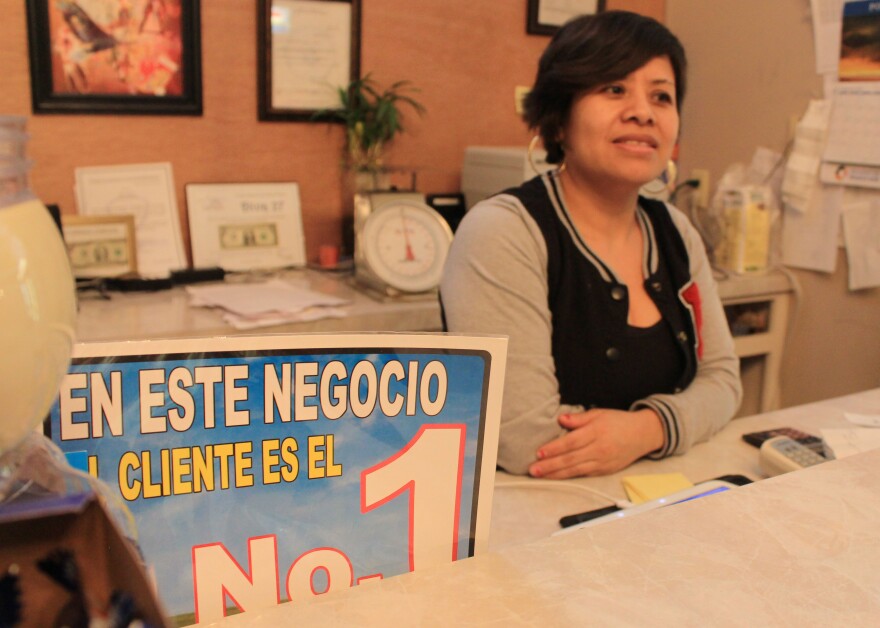You might not expect to find too much of Mexico in Missouri. But small towns across the state, like Mexico, Missouri are adapting to a growing Latino population.
The last census reported the state of Missouri saw a nearly 80 percent increase in the Latino population from 2000 to 2010.
So it’s no surprise to hear conversations in Spanish when you step into Diva 27, a Mexican grocery and clothing store in Mexico. Boxes of tortillas, fresh sweet bread, spices and figurines of famous Mexican comedians line the shelves.
But a store like Reina Hernadez’s Diva 27 hasn’t always been around.
“It was hard to find Mexican things, even clothes,” she said through a translator. “It’s changed a lot. Now it’s more common to see Mexican people. Before, it was a little strange.”
For years, Hernandez had to make the 240-mile round trip journey to St. Louis every two weeks because there wasn’t a local ethnic food store.
She saw an opportunity to meet the demands of a growing demographic when she opened her own store in 2012, and with good reason.
Audrain County experienced a 252 percent increase in the Latino population from 2000 to 2010, according to the last U.S. Census.
“There are people who come from Perry and other towns to my store,” Hernandez said. “To start a business here, or to do anything big here in the U.S. is a dream I think everyone who comes here has.”
But it also runs in Hernadez’s blood. Her grandmother opened the first neighborhood store in their small town of about 600 in Mexico.
“She taught me that the love you have for what you do will keep you going,” Hernandez said.
Hernandez came to Mexico, Missouri, in 2001 along with 19 others from Selma, California – one of the first waves of Latinos coming to work at the Continental Products plant.
“What happened was that a guy who worked at the factory knew a cousin of mine who was in California,” Hernandez said. “And so they got to talking and they said, ‘We need people to work in the factory’. Then my cousin started asking people, “Hey, do you want to go to Missouri to work?”
Soon after, their families and friends from the country of Mexico followed.
Now, people who were once neighbors in Oaxaca, Mexico are neighbors in Mexico, Missouri. They even have a special name for each other: “Oaxacitas.”
But, migrants moving to a town in groups isn’t all that unusual.
“If somebody gets a position in a plant like that, sometimes you’ll find that almost everyone who works in that plant comes from the same community in Mexico or Guatemala or wherever it is they’re coming from because of those networks,” said Steve Jeanetta, the state specialist for community development at the University of Missouri.
Though there is a strong sense of community among the Latinos here, this bond doesn’t always extend to the rest of the town.
That’s something Father Mark Porterfield is working to improve as the pastor at St. Brendan Catholic Church.
“Some of my parishioners were assisting me in translating and that type of thing,” Porterfield said “And from that point on we just decided we weren’t ministering to Hispanics, we weren’t ministering to the Spanish speaking people.”
Last summer he went to Guadalajara, Mexico, to learn Spanish. Now, he’s the one running the monthly Spanish Mass at St. Brendan’s that started two years ago.
About 10 to 15 non-Latinos attend the monthly Masses. There are snacks and appetizers after the service, giving people a chance to socialize.
And it seems to be working, at least according to Luz Coil, a Latino leader at the church.
“I see a lot of the Hispanic community there at those English Masses,” she said through a translator. “They’re not afraid to come because they know they can participate too. They have a bilingual missal. And they’re interested in integrating with the American community.”
She wants to see this connection extend beyond the church and into the day-to-day lives of Mexico’s community members.
“The idea is to integrate everyone, so it’s one family. So it’s not “gringos” or Hispanics, or Latinos. No. Just one community where everyone is integrated.”
That’s a weekly occurrence at Garcia’s Market, another Mexican grocery store that opened in town about a year ago. Non-Spanish speakers walk into the store with hopes of leaving with more than just spices or bread.
“They say, ‘I’ll buy something, but teach me something in Spanish. And I’ll teach you a word,’” said a worker at Garcia’s Market, through a translator. “They don’t leave until I pronounce the word correctly.”
Then she has the chance to share some of her language with her customers.
“They flip their words around,” she added. “ Sometimes they say, “Que valor tiene es esto?” And I say, ‘No, it’s not that. It’s ‘Cuanto cuesta eso? They won’t understand you in another Mexican store if you say that,’ I tell them,” she said.
At Diva 27, Hernandez has had similar experiences. For her, living in Missouri for 14 years has not only meant leaving the Mexico she knew, but watching her new Mexico grow into a place welcoming of her native culture.


